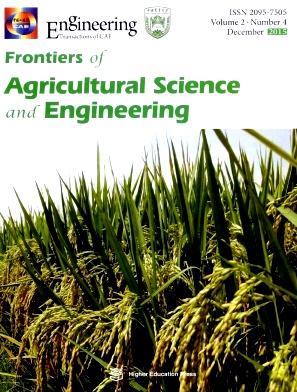CHARACTERISTICS OF HERBIVORY/WOUND-ELICITED ELECTRICAL SIGNAL TRANSDUCTION IN TOMATO
IF 2.8
4区 农林科学
Q1 AGRONOMY
引用次数: 4
Abstract
ABSTRACT Electrical signals commonly occur in plants in response to various environmental changes and have a dominant function in plant acclimation. The transduction of wound-elicited electrical signals in the model plant species Arabidopsis has been characterized but the characteristics of electrical signal transduction in response to herbivory or wounding in crop species remain unknown. Here, the features of electrical signals elicited by insect herbivory and wounding in tomato were investigated. Unlike those in Arabidopsis , wounding tomato leaves did not cause leaf-to-leaf electrical signal transduction. In contrast, electrical signals elicited in response to petiole wounding were stronger and more strongly transduced. Lea fl et wounding also activated electrical signal transduction and jasmonic acid (JA) signaling within the whole compound leaf. It was also demonstrated that tomato glutamate receptor-like 3.3 (GLR3.3) and GLR3.5 mediated lea fl et-to-lea fl et electrical signal transduction. Herbivory-induced番茄草食/伤致电信号转导特性研究
电信号是植物对各种环境变化的普遍响应,在植物的驯化过程中起着主导作用。在模式植物拟南芥中,创伤引发的电信号的转导已经被表征,但在作物物种中,对草食或伤害的电信号转导特征仍不清楚。本文研究了昆虫取食和伤害对番茄电信号的影响。与拟南芥不同,番茄叶片损伤不会引起叶片间的电信号转导。相反,叶柄损伤引起的电信号更强,转导更强。叶片损伤还激活了整个复叶的电信号转导和茉莉酸信号转导。研究还表明,番茄谷氨酸受体样3.3 (GLR3.3)和GLR3.5介导了叶片间的电信号转导。Herbivory-induced
本文章由计算机程序翻译,如有差异,请以英文原文为准。
求助全文
约1分钟内获得全文
求助全文
来源期刊
CiteScore
5.10
自引率
2.70%
发文量
33
期刊介绍:
Frontiers of Agricultural Science and Engineering (FASE) is an international journal for research on agricultural science and engineering. The journal’s aim is to report advanced and innovative scientific proceedings in agricultural field including Crop Science, Agricultural Biotechnology, Horticulture, Plant Protection, Agricultural Engineering, Forestry Engineering, Agricultural Resources, Animal Husbandry and Veterinary Medicine, Applied Ecology, Forestry and Fisheries. FASE is committed to provide a high level scientific and professional forum for researchers worldwide to publish their original findings and to utilize these novel findings to benefit the society.

 求助内容:
求助内容: 应助结果提醒方式:
应助结果提醒方式:


